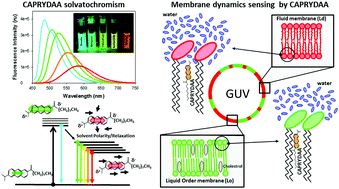CAPRYDAA, an anthracene dye analog to LAURDAN: a comparative study using cuvette and microscopy†
Abstract
We synthesized an anthracene derivative with solvatochromic properties to be used as a molecular probe for membrane dynamics and supramolecular organization. A nine carbon atom acyl chain and a dimethylamino substitution were introduced at positions 2 and 6 of the anthracene ring, respectively. This derivative, 2-nonanoyl-6-(dimethylamino)anthracene (termed CAPRYDAA), is a molecular probe designed to mimic the well-known membrane probe LAURDAN's location and response in the lipid membranes. Due to the larger distance between the electron donor and acceptor groups, its absorption and emission bands are red-shifted according to the polarity of the media. The photophysical behavior of CAPRYDAA was measured in homogeneous media, synthetic bilayer and cells, both in a cuvette and in a fluorescence microscope, using one and two-photon excitation. Our results show a comparable physicochemical behavior of CAPRYDAA with LAURDAN, but with the advantage of using visible light (488 nm) as an excitation source. CAPRYDAA was also excitable by two-photon laser sources, making it easy to combine CAPRYDAA with either blue or red emission probes. In GUVs or cells, CAPRYDAA can discriminate the lipid phases and liquid–liquid phase heterogeneity. This new membrane probe shows the bathochromic properties of the PRODAN-based probes designed by Weber, overcoming the need for UV or two-photon excitation and facilitating the studies on the membrane properties using regular confocal microscopes.

- This article is part of the themed collection: Celebrating Latin American Talent in Chemistry


 Please wait while we load your content...
Please wait while we load your content...